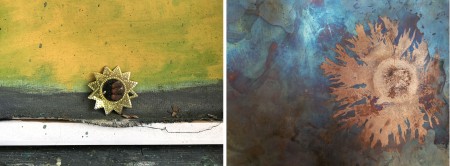organized by Lillian O'Brien Davis
22 October to 21 November 2020

Contact is a many layered metaphor; both touch and its absence have consequences that can extend indefinitely. I look at my hands. They feel huge, like mitts that will cover, crush, or make a mess. I am frightened that the marks they make will last too long, be too big, cause unpredictable outcomes. When I do make contact, the effects are not immediate—this delay temporarily alleviates my fears. However, all marks, all instances of contact, eventually appear. While contact may signal a crisis, its lack also torments, like the aching feeling when something lies just out of grasp. Consider the story of Tantalus, that figure from Greek mythology who stole ambrosia, nectar, and the gods’ secrets of immortality for his people. As punishment for his crime, Tantalus was made to stand in a clear pool where water receded before he could drink, underneath trees laden with fruit that forever escaped his grasp. Touching leaves traces, often more lasting than originally thought, but the absence of touch builds both anticipation and desire.
Greener than Grass engages qualities of contact—between people, surfaces, and objects—to examine haptic intimacy and explore the causal relationship between artworks and the many structures that make contact with them (physically, intellectually, emotionally, institutionally, historically). Curated through a series of collaborative conversations orbiting around desire and reverberations of touch in its various manifestations, the works in the exhibition are sites of accrual and records of presence.
How do you visualize the space in between where two things meet? Between Tantalus and his environment; between your skin and mine; between the world we inherit and the one we hope for? Imagined touch is erotic—anticipation, a fantasy of contact that never arrives, intimate and infinite nearness. How do we reckon with imagined touch versus real contact? Our direct implication in the world? Action creates relays between entities, echoes that reverberate into the space of in-between, traces remain. What would it look like to escape our barriers?1
Programmed events throughout the run of the exhibition, including a writing workshop and mail exchange (dates tba) consider the artworks’ meaning, significance, and method of installation while allowing space for looser, sociable conversations.
1 Adapted from statement by Cecily Chen, Andrew Howard, William Kahn, Grace Knight, Jonida Kupa, Amy Marcus, Charlie Sosnick, and Zoe Stoller in 1000 Infrathins. Edited by Kenneth Goldsmith. Philadelphia, PA: Center for Programs in Contemporary Writing University of Pennsylvania, 2018.

